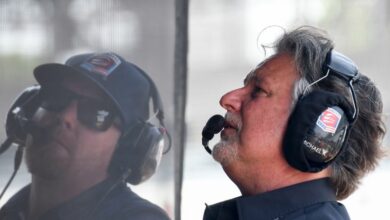A Comprehensive History Of The Eboladrome
The Grand Tour’s test track, better known as the Eboladrome, is a narrow, dangerous ribbon of road that currently plays host to The Grand Tour’s loud, smoky power tests. But while the track itself is new, the airfield’s been around for decades. So what did it do before? Quite a lot, as it turns out.

The Eboladrome is built on a WWII airfield in Wiltshire known as RAF Wroughton, named after the nearby village and prefixed for its use by the Royal Air Force and, later, the Royal Navy. It was constructed on the 1st of April, 1940, at a time when Britain was stocking up on airfields to use in the coming years of conflict. From 1941 until the 1990s, the area’s primary use was as the RAF General Hospital, catering to a maximum of 1000 patients by the spring of 1944.
> Find the complete list of lap times here
In July 1967, Princess Alexandra, granddaughter of King George V and neice of Queen Elizabeth, visited the hospital, leading the Queen to rechristen it in her honor. Known from then on as the RAF Princess Alexandra Hospital, it remained a military general infirmary for several years, catering notably in 1982 to wounded returning from the ongoing Falklands War.

The hospital came to an end on March 31, 1996, a victim of defense cuts following the Cold War at the hands of the fresh Conservative government. The building itself stayed around until 2004, when it was demolished to make way for housing developments. The site has been far from barren, however; in 2016, approximately 165 acres of the airfield were converted to a massive 50-megawatt solar farm containing 150,000 solar panels. Nearby is housed the Science Museum at Wroughton, which has used the airfield for large object storage since the 1970s; they remain the area’s current owners.

In 2016, The Grand Tour’s test track was constructed at the north end of the field in only a few days using a combination of the existing ring road and fresh pavement. It’s worthy to note that Old Lady’s House is indeed real, and wasn’t built to serve as part of the track.
Unfortunately, RAF Wroughton isn’t open to the public these days; a shame, as aside from the airfield itself, the site is still home to several surviving Army pillboxes from World War II. But it’s refreshing to know that aside from its noble modern purpose as a cathedral of speed and smoke, it had real meaning in the past to thousands of people as well.
UPDATE:
Several commenters indicated that Old Lady’s House was not, in fact, built for the show. We apologize for this factual error, and the article has been updated to reflect this. Thank you to Facebook commenter Jennifer Clare Brown for pointing this out and providing a photo!


